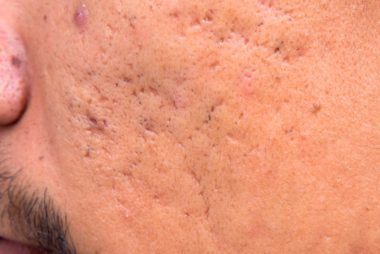Acne Scar Treatment in Gurgaon
 Treating acne scars and treating active acne are two different skin concerns. In acne, a buildup of bacteria and sebum in the sebaceous follicle causes injury. The body responds by rushing white blood cells and inflammatory molecules to the area to heal and prevent infection. After the infection heals the damaged tissue sometimes does not return to its former state causing scarring. In severe cases of nodular acne where a larger infection occurs in the deeper layers of skin, there can be tissue loss and permanent scarring. Some patients with intense inflammation can end up with significant disfiguring scars.
Treating acne scars and treating active acne are two different skin concerns. In acne, a buildup of bacteria and sebum in the sebaceous follicle causes injury. The body responds by rushing white blood cells and inflammatory molecules to the area to heal and prevent infection. After the infection heals the damaged tissue sometimes does not return to its former state causing scarring. In severe cases of nodular acne where a larger infection occurs in the deeper layers of skin, there can be tissue loss and permanent scarring. Some patients with intense inflammation can end up with significant disfiguring scars.
Blackheads-do they cause scars?
Blackheads form when dead skin cells mix with sebum and clog up the pores. Exposure to the air oxidizes the top causing it to discolor and appear black. Blackheads alone cannot cause scarring but squeezing and picking at them can cause permanent scars. Prevention and proper treatment is the key to avoid scarring.Types of Acne scars
A macule is the flat, red or brown mark that a healed pimple leaves behind. Usually this leaves no permanent mark on the skin and it is not really a scar, but can take months to fade away completely.
Post inflammatory pigmentation is the discoloration of skin where an inflamed pimple has healed.
Atrophic scars are pitted but have smooth borders and are not as deep.
Ice pick scars are deep pitted scars with steep edges. They are jagged and deep like ice pick stabs on the skin. This type of scarring is a result of tissue loss from deep, nodular acne.
Depressed fibrotic scars are generally very large, steep and sharp. Ice pick scars can develop into depressed fibrotic scars over time.
Hypertrophic scars, more common on the back and chest, are thick, lumpy scars that sit above the surface of the skin.
Open pores are not acne scars and are not the direct result of picking at a pimple. Open pores are primarily genetic. Dirt and oil can stretch the pores.
If you have both scarring and active acne, it is better that you start with an anti-acne treatment regime first and address the scarring issue once the acne is under control.
Laser Treatment of Acne Scars
The most effective treatment for the majority of patients with acne scars is the Fractional CO2 Laser (the most advanced laser in this class is Lumenis UltraPulse Active FX, Deep FX) This is called "fractional" laser because the laser works by resurfacing only a "fraction" of the skin at a time, leaving the intervening area intact for faster healing. This vastly reduces the incidence of side effects and has given us the ability to treat all skin types.
 Helios II [Q-switched NdYag Laser] is the laser of choice for non-ablative skin resurfacing for acne scars. With this laser, there is little risk of side effects and downtime is minimal.
Helios II [Q-switched NdYag Laser] is the laser of choice for non-ablative skin resurfacing for acne scars. With this laser, there is little risk of side effects and downtime is minimal.
At Bindal clinic, UltraPulse Lumenis and Helios II laser treatments for acne scars are combined with microdermabrasion, derma rollers, subcision, chemical peels, medications and other treatments to make it customized according to your individual requirements. This customized treatment is decided by an experienced dermatologist to achieve best results for you.
Laser Treatments
- Acne Scar Treatment
- Surgery Scars
- Old Wound Scars
- Hypertrophic Scar/Keloids
- Burns Scars
- Chicken Pox Scars
- Pigmentation
- Under Eye Dark Circles
- Nevus/Birth Mark
- Mole Removal
- Under Arm Pigmentation
- Face Rejuvenation
- Warts & Skin Tags
- Laser Tattoo Removal
- Stretch Marks Laser Treatment
- Laser Hair Removal
Working Time
- Mon-Sat
9.30 AM - 1.30 PM
5.30 PM - 8.00 PM
Saturday
9.30 AM - 1.30 PM
Contact Info
-
Phone: 9810030327
9560400327 - bindalclinic@gmail.com
